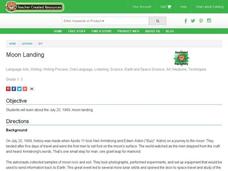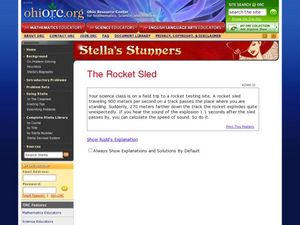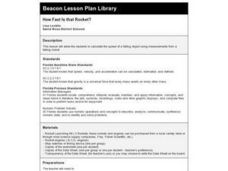Curated OER
Strawkets and Control
Learners investigate the effect that fins have on rocket flight. They construct two paper rockets that they can launch by blowing through a straw, one with fins and one with wings, and observe and record the results of the rocket flights.
Curated OER
Strawkets and Thrust
Learners investigate the effect of thrust on rocket flight. They construct two paper rockets, one with a smaller exit nozzle, and compare/contrast the distances traveled by the rockets.
Curated OER
Thunderbirds: Forces
Students investigate the concepts of thrust and how rockets are launched into the air. They watch a clip of the television show Thunderbirds, and draw a basic diagram of the Thunderbird ships, labeling it with arrows to identify the...
Curated OER
Moon Landing
Students research about the July 20, 1969, moon landing. They demonstrate their knowledge of the first moon landing by creating peek-a-boo rocket books. Also they can make their own moon rocks with an easy-to-make dough.
Curated OER
The Rocket Sled
In this secondary mathematics worksheet, students use the given information regarding a rocket’s distance and time to calculate the speed of sound. The one page worksheet contains one problem with the solution.
Curated OER
How Fast Is that Rocket?
Eighth graders calculate the speed of a falling object using measurements from a falling rocket. They report data from their data sheet to the teacher to record on the board or on the overhead transparency and discuss the results with...
Curated OER
How Do Probes Get To Space
Students investigate how force works to propel rockets into outer space. In this physics lesson, students use a drinking straw, fishing line, a balloon, and tape to explore how force works in outer space. Students repeat the experiment...
Curated OER
Alka Rockets! An Introduction to Kinetics
Students identify the factors that influence reaction rates. In this chemistry lesson, students design an experiment to test one factor they identified. They perform the experiment and share the results to the entire class.
Curated OER
Soda Pop Can Hero Engine
Young scholars view a demonstration on Newton's Laws of Motion using a soda can. In this Newton's law instructional activity students discuss what they learned from the demonstration.
Curated OER
Space Day Activities
Celebrate Space Day on May 7th with aerospace lessons that are sure to get kids excited about science and engineering!
Olathe Public Schools
Forces, Net Forces & Acceleration
Pass along the knowledge of the great Sir Isaac Newton with this worksheet on the laws of motion. Including three separate problems, each involving multiple parts and calculations, this resource is a great way to...
Freecloud Design
Monster Physics™
Physics fanatics will shriek over this monster-themed construction application! They design an invention with the intention of competing one of 50 missions and test it out with real physics applications.
Cornell University
Atomic Bonding
Explore the connection of surface area to bonding within atoms. Learners complete lab investigations to model changing surface area with different sizes and concentrations of atoms. A flour fireball demonstration follows the labs to...
NASA
Newton Car
If a car gets heavier, it goes farther? By running an activity several times, teams experience Newton's Second Law of Motion. The teams vary the amount of weight they catapult off a wooden block car and record the distance the...
Curated OER
Solar Arrays for the Space Station
Students explore the challenges that are faced when transporting materials into space. They review the various forms of energy, including solar arrays, that are used on the International Space Station and how generating this energy calls...
Teach Engineering
Projectile Magic
What do the movies October Key and Harry Potter and the Sorcerer's Stone have in common? The fourth installment of a five-part module presents equations regarding projectile motion and how to rearrange them. Scholars view video clips...
Teach Engineering
Magical Motion
Make solutions to projectile motion problems magically appear using equations. Pupils watch a clip from a Harry Potter movie and find the length of time it takes for a remembrall to fall into Harry's hands. They use a projectile motion...
Beauty and Joy of Computing
Combining List Operations
Use list operations to modify an earlier version of Tic Tac Toe. The fourth lab in a series of five has pupils combine list operations to build more powerful operations. They take a project from a previous unit and enhance it to keep...
Cornell University
Predicting Chemical Reactions
Prove the Law of Conservation of Mass through a lab investigation. A well-designed lesson asks groups to combine materials and monitor indicators for chemical reactions. Measuring the mass of the reactants and products allows individuals...
Curated OER
Edible Mars Spacecraft
Fourth graders identify the Mars Global Surveyor and Mars Pathfinder and the rover, Sojourner.
Mr. E. Science
Manned Space Exploration: From Apollo to Present
How did the manned space mission program progress? The presentation covers American space exploration from the Apollo missions through the International Space Station.
Urbana School District
Waves
What is a physicist's favorite part of sports? Doing the wave. The presentation covers longitudinal, transverse, surface, and standing waves. It includes in-depth information on frequency, wavelength, period, amplitude, reflection,...
American Museum of Natural History
The Amazing Mundo
Rocks and minerals are great on their own, but they also turn into some pretty amazing stuff! An online lesson explains the different types of materials we get from rocks and minerals, including glass, plastic, and coins. An embedded...
Curated OER
Altitude Tracking
Students estimate the altitude of a rocket during several flights. They create their own altitude tracking devise. They examine and discuss their results at the end of the activity.
Other popular searches
- Simple Rocket Science
- Science Fair Bottle Rocket
- More Rocket Science
- Physics of Rocket Science
- History of Rocket Science























